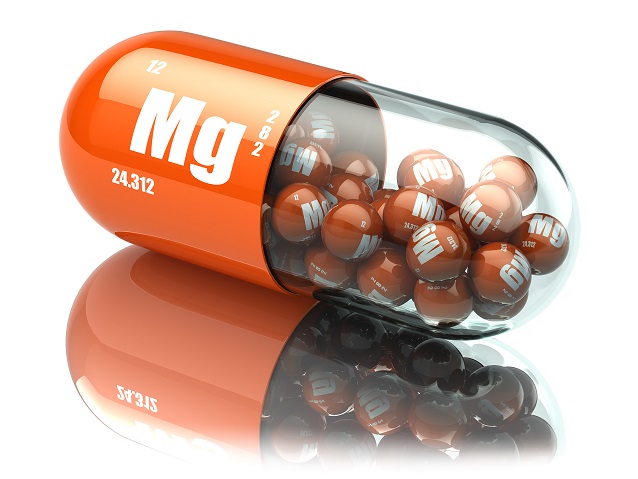Magnificent Magnesium
Our farmers and grandmothers know this remedy very well, previously offered in the form of inexpensive and highly effective magnesium chloride, used topically or internally for both animals and their breeders as anti-infectious, antifatigue, and even antirickets.
Today, scientific research has revealed hundreds of properties of magnesium that rank it among the most indispensable minerals for our health and as an ally for treatment of cardiovascular, infectious, metabolic, nervous, rheumatological, and hormonal conditions.

Simply Indispensable!
The properties of magnesium are numerous, from a biochemical point of view: It balances calcium with neuromuscular transmission; it triggers the metabolism of carbohydrates and amino acids; it potentiates the bioavailability of potassium, vitamins B6, E, and C, as well as silicon; it ensures the transformation of all B vitamins into coenzymes; and it allows the enzymatic functioning of the body as well as the synthesis of nucleic acids or hormones (for example, it is useful with zinc and B6 for the synthesis of prostaglandins from omega-3s and -6s). From a functional point of view, it helps the acid-base balance and the regulation of body temperature, promotes the intestinal absorption of lipids, plays a role in the adaptation to stress of the heart and brain, stimulates the immune system, prevents arterial plaque formation, and maintains fluidity of the blood. In short, it ranks among the keystone minerals for metabolic function.
Supplementation and Dosage
Today, we have advanced formulas, combining synergistic magnesium molecules such as l-taurine and vitamin D that enhance absorption, and clinically proven ratios between calcium and magnesium to properly remineralize the skeletal system. Also available are highly absorbable forms such as magnesium bisglycinate, one of the best-tolerated and best-assimilated forms of magnesium, as the whole compound is transported through the intestinal wall, which decreases the risk of diarrhea and provides glycine, a calming amino acid often deficient in many people. The recommended daily dose is approximately 400 mg, noting that only 30–40% of the magnesium in food is absorbed in the small intestine. Athletes, pregnant and breast-feeding women, the elderly, and those who are ill have higher needs (500 to 600 mg).
Magnesium Deficiency: Causes and Consequences
The effectiveness of magnesium is negatively affected by alcohol, excess coffee and tea, and stress. Many medications—including birth-control pills, antibiotics, asthma products, and cortisone—soft-drink phosphates, and sweeteners like aspartame deplete magnesium. In addition, intensive farming, the treatment of running water, and especially the refining of food has drastically reduced the magnesium content of our food (for example, 80% is lost between wheat and refined white flour). Just like vitamin D, there are few who enjoy an optimal level of magnesium, as most of the population is deficient (as of 1997, the National Academy of Sciences had estimated that more than 70% of Americans had a magnesium deficiency). In parallel with this phenomenon, most diseases of our civilization are accompanied by a serious deficiency of magnesium, which is critical for the proper functioning of cells.
Magnesium also regulates the entry of calcium into cells. Among the clinical consequences of this unbalanced calcium/magnesium-induced cell dysfunction are:
- Hyperinsulinemia and insulin resistance for adipocytes, muscle, liver, and pancreatic cells;
- Heart problems due to the exacerbated enlargement and contractibility cells of the heart;
- Thrombosis with platelet aggregation;
- Hypertension due to cortisol release from the adrenal cells, sodium retention in renal cells, and stiffening of blood-vessel cells;
- Irritability, hyperactivity, etc., due to the overstimulation of nerve cells; and
- Muscle cramps and migraines.
Do not Panic: There Are Solutions!
At your local farmers’ market this weekend, you can stock up on plant-based foods rich in magnesium such as seaweed, tofu, almonds, avocados, cereals rich in bran, bananas, dates, figs, wheat germ, dark green vegetables, legumes, squash and pumpkin seeds, hazelnuts, and walnuts. Magnesium is also found in shellfish and seafood, fish, dairy products, and meat—however, in much lesser quantities.
At your local health-food store, you’ll be looking for a magnesium bisglycinate supplement to ensure optimal daily intake, possibly with magnesium chloride for a relaxing bath with some lavender or bitter orange essential oil.
References
- Firoz, M., and M. Graber. “Bioavailability of US commercial magnesium preparations.” Magnesium Research, Vol. 14, No. 4 (2001): 257–262.
- Schuette, S.A., et al. “Bioavailability of magnesium diglycinate vs magnesium oxide in patients with ileal resection.” Journal of Parenteral and Enteral Nutrition, Vol. 18, No. 5 (1994): 430–435.
- Grosdidier, R. Le guide des compléments alimentaires, Paris: Guy Trédaniel, 2011, 295 p., ISBN 978-2-8132-0259-8.
- Seelig, M.S., and A. Rosanoff. The magnesium factor, New York: Avery, 2003, 384 p., ISBN 978-1-5833-3156-9.
 Guillaume Landry, MSc, Naturopath
Guillaume Landry, MSc, Naturopath
A native of the Jura mountains of eastern France, he shares
his passion for the wonders of nature and natural medicine.

 Stores
Stores


